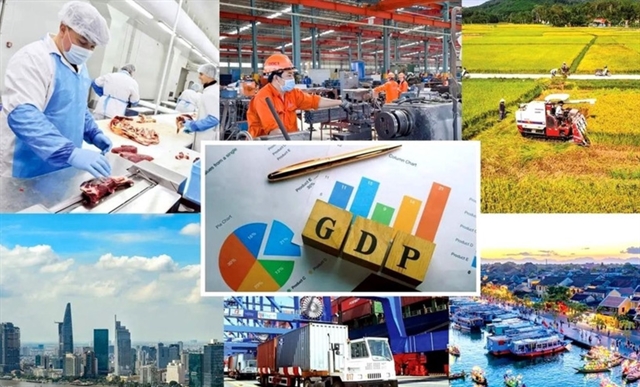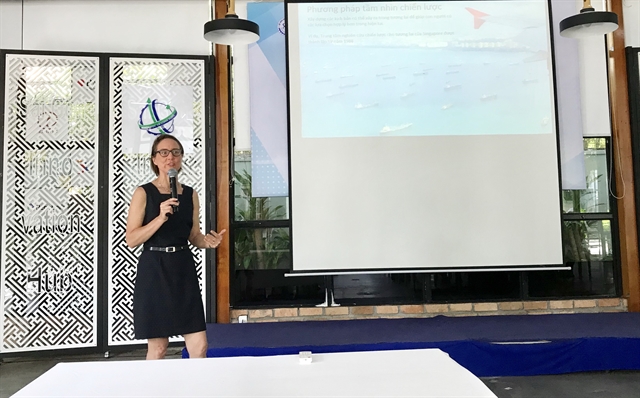 Economy
Economy

Việt Nam should take advantage of the next wave of digital technologies such as blockchain, Artificial Intelligence, Internet of Things and cloud-based services to become Asia’s next high-performing economy and improve the living standards of its residents, experts urged at a meeting held on Wednesday (May 22) in the city.

|
| Dr Lucy Cameron, lead author of the report “Việt Nam’s Future Digital Economy Towards 2030 and 2045”, speaks at a meeting held on Wednesday in the city. — VNS Photo Bồ Xuân Hiệp |
HCM CITY — Việt Nam should take advantage of the next wave of digital technologies such as blockchain, Artificial Intelligence, Internet of Things and cloud-based services to become Asia’s next high-performing economy and improve the living standards of its residents, experts urged at a meeting held on Wednesday (May 22) in the city.
Dr Lucy Cameron, lead author of the “Việt Nam’s Future Digital Economy Towards 2030 and 2045” report and Australian senior research consultant, said the country should carefully navigate a number of risks while undertaking digital transformation.
“Việt Nam has been one of the world’s fastest-growing economies and has already become one of the most dynamic countries in the East Asia region,” she said.
A boom in digital hardware and software exports has occurred, and Việt Nam’s young population is rapidly taking up new mobile internet services, the report said.
The Government is also implementing Industry 4.0 policies to modernise major existing industries and develop new ones, it added.
Digital transition is expected to add about 1.1 per cent of GDP growth each year for Việt Nam by 2045, while Việt Nam’s growth is fast and inclusive, which is suitable for digital transformation, according to Cameron.
But to sustain high growth, Việt Nam will need to overcome substantial challenges, Cameron said.
The population is ageing, while climate change and rapid development is straining the environment and food production as the country rapidly urbanises.
The workforce needs to learn higher-level skills, especially as jobs are becoming automated in the agriculture and manufacturing sectors.
Nguyễn Văn Bình, chairman of the Central Economic Commission, said that mastering the digital economy created an opportunity for Việt Nam to maintain rapid and sustainable growth through the next phase of development.
“Strong leadership and institutions will be key in Việt Nam’s development across all economic sectors, including the private sector,” he said. “Digital transformation resulting from this strong leadership will unblock bottlenecks to promote further economic development.”
Chu Ngọc Anh, minister of Science and Technology, said the report provided a blueprint for the country to plan for the country’s digital future.
“It is a tremendous example of successful collaboration between our national innovation systems,” he said.
Craig Chittick, Australian Ambassador to Việt Nam, said the report was the first major output of the Aus4Innovation partnership between Australia and Việt Nam.
“It will guide our work over the next three years as we deepen the collaborative linkages between our two countries and help strengthen the Vietnamese innovation system as it adapts to the challenges and opportunities of the digital economy,” he said.
Australia has worked with Việt Nam to identify seven mega-trends affecting Việt Nam’s future digital economy.
These include the impact of emerging digital technologies, new export markets for Việt Nam, the development of modern digital infrastructure, the push to smart cities, the rise of digital skills and services, and changing consumer behaviours.
Mega-trends informed the report’s development of four potential future scenarios, which provide a blueprint for decision-makers to plan for Việt Nam’s future digital economy.
With a young population, high investment and a location in the heart of high-growth Asian economies, Việt Nam has a good chance of surging forward with new digital tools, if the transition is managed well.
Digital economy
In 2017, the “Việt Nam’s Future Digital Economy Towards 2030 and 2045” report was launched by the Ministry of Science and Technology and the Commonwealth Scientific and Industrial Research Organisation.
The report provides economic modelling for potential scenarios of growth for Việt Nam’s digital economy up to 2045.
It aims to serve as a strategic decision-making tool for leaders in government and businesses negotiating the new wave of digital innovation and the next phase of economic development.
The first report “Việt Nam Today”, which was released last year, examined the state of Việt Nam’s macro-economy and digital economy.
The present report, which was released in May, updates this research and examines the state of Việt Nam’s economy and digital economy in early 2019 with a main focus on the agriculture and manufacturing sectors.
The report is part of the Việt Nam’s Future Digital Economy project, an innovative joint venture between the governments of Việt Nam and Australia.
The project is the first major output of the Aus4Innovation programme launched in 2017 by the governments of Việt Nam and Australia. — VNS




